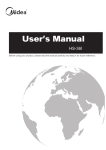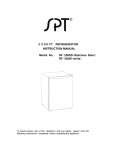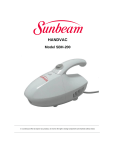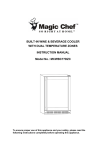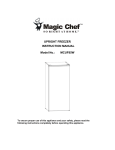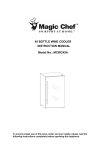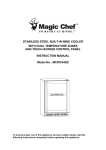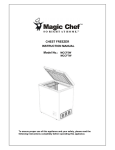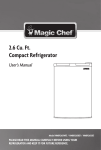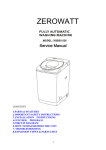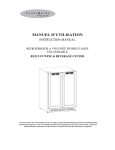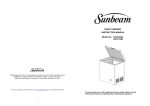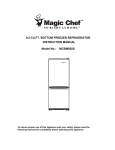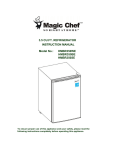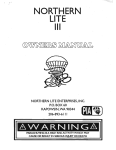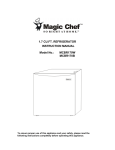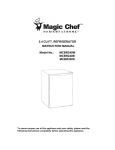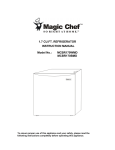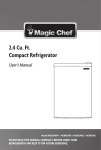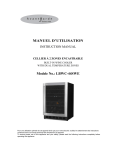Download Magic Chef MCBM920S1 Use and Care Manual
Transcript
9.2 Cu. Ft. MCBM920W1 / MCBM920S1 Important Safety Instructions To reduce the risk of fire, electrical shock, or injury follow these basic precautions when using your refrigerator. 1) WARNING―Keep ventilation openings, in the appliance enclosure or in the built-in structure, clear of obstruction. 2) WARNING―Do not use mechanical devices or other means to accelerate the defrosting process, other than those recommended by the manufacturer. 3) WARNING―Do not damage the refrigerant tubing to increase the risk of a leak when handle, move and use of refrigerator. 4) WARNING―Do not use electrical appliances inside the food storage compartments of the appliance, unless they are of the type recommended by the manufacturer. 5) WARNING―DANGER: Never allow children to play with, operate, or crawl inside the refrigerator. Risk of child entrapment. Before you throw away your old refrigerator or freezer: ·Take off the doors ·Leave the shelves in place so that children may not easily climb inside. 6) The appliance has to be unplugged before carrying out user maintenance on the appliance. 7) This appliance can be used by children age 8 years and above and persons with reduced physical sensory or mental capabilities or lack of experience and knowledge if they have been given supervision or instruction concerning use of the appliance in a safe way and understand the hazards involved. Children should not play with the appliance. Cleaning and maintenance should not be made by children without supervision. 8) If the component part is damaged, it must be replaced by the manufacturer, its service agent or similar qualified persons in order to avoid a hazard. 9) Please abandon the refrigerator according to local regulations as the unit contains flammable blowing gas and refrigerant. 10) Follow local regulations regarding disposal of the appliance due to flammable refrigerant and Blowing gas. All refrigeration products contain refrigerants,which under the guidelines of federal law must be removed before disposal. It is the consumer's responsibility to comply with federal and local regulations when disposing of this product. 11) This appliance is intended to be used in household and similar environments such as ·staff kitchen areas in shops, offices and other working environments; ·farm houses and by clients in hotels, motels and other residential type environments; ·bed and breakfast type environments; ·catering and similar non-retail applications. 12) Do not store or use gasoline or any inflammable liquors and liquids inside or in the vicinity of refrigerator. 13) Do not use an extension cord with this appliance. If the power cord is too short, have a qualified electrician install an outlet near the appliance. Use of an extension can negatively affect the unit’s performance. IT IS HAZARDOUS FOR ANYONE OTHER THAN AUTHORIZED SERVICE PERSONNEL TO CARRY OUT SERVICES OR REPAIRS INVOLVING THE REMOVAL OF COVERS. TO AVOID THE RISK OF AN ELECTRICAL SHOCK DO NOT ATTEMPT REPAIRS YOURSELF. 1 TABLE OF CONTENTS NAMES OF THE PARTS……………………………………………………… 2 SPECIFICATIONS…………………………………………………………….. 3 IMPORTANT SAFETY INSTRUCTIONS…………………………………… 4 INSTALLATION INSTRUCTION BEFORE USING YOUR REFRIGERATOR……………………..…… 4 INSTALLING YOUR REFRIGERATOR ……………………………… 4 ELECTRICAL CONNECTION………………………………………… 5 OPERATING THE REFRIGERATOR TEMPERATURE CONTROL………………………………………….. 6 OPERATING THE FREEZER COMPARTMENT TEMPERATURE CONTROL………………………………………….. 6 ICE TRAY………………………………………………………………… 6 THE FREEZER COMPARTMENT……………………………………. 6 CHANGING THE LIGHT……………………………………………………….. 7 CHANGING THE REVERSIBLE DOOR ……………………………………… 7-8 CARE AND MAINTENANCE CLEANING YOUR REFRIGERATOR………………………………… 9 VACATION TIME………………………………………………………. 9 MOVING YOUR REFRIGERATOR…………………………………… 9 ENERGY SAVING TIPS………………………………………………. 9 TROUBLESHOOTING GUIDE………………………………………………. 10-11 REFRIGERATOR WARRANTY……………………….…………………….. 12 NAMES OF THE PARTS MODEL NO. MCBM920W1/MCBM920S1 1 2 3 4 5 6 Interior Light Refrigerator Temperature Control Freezer Temperature Control Refrigerator Shelves Glass Crisper Cover Crisper aWARNINGa: 7 8 9 10 11 Freezer Shelf Freezer Basket Refrigerator Door Racks Can Dispenser Bottle Storage Bin Never touch the interior of the Freezer Chamber or frozen foods in the compartment with wet hands as this could result in frost bite. 2 SPECIFICATIONS – Model # MCBM920W1 Product Description Magic Chef Refrigerator MCBM920W1 Model No. Capacity Unit Dimensions ( inches ) 9.2 Cu. Ft. Width Height Depth 23 4/5” 59 4/5” 26 2/3” Net Weight ( lbs) 128( lbs ) SPECIFICATIONS – Model # MCBM920S1 Product Description Magic Chef Refrigerator MCBM920S1 Model No. Capacity Unit Dimensions ( inches ) 9.2 Cu. Ft. Width Height Depth 23 4/5” 59 4/5” 26 2/3” Net Weight ( lbs) 130( lbs ) 3 IMPORTANT SAFETY INSTRUCTIONS aWARNINGa • • • • • • • To reduce the risk of fire, electrical shock, or injury when using your refrigerator, follow these basic precautions: Read all instructions before using the refrigerator. DANGER or WARNING: Risk of child entrapment. To avoid the possibility of child entrapment, please take the following precautions before throwing out the refrigerator. - Remove all doors from the unit. - Leave the shelves in place so that children may not easily climb inside. Never allow children to operate, play with, or crawl inside the refrigerator. Refrigerants: All refrigeration products contain refrigerants, which under the guidelines of federal law must be removed before disposal of product. It is the consumer’s responsibility to comply with federal and local regulations when disposing of this product. Never clean refrigerator parts with flammable fluids. The fumes can create a fire hazard or explosion. Do not store or use gasoline or any other flammable vapors and liquids in the vicinity of this or any other refrigerator. The fumes can create a fire hazard or an explosion. -Save these instructions- INSTALLATION INSTRUCTIONS Before Using Your Refrigerator • Remove the exterior and interior packing. • Before connecting the refrigerator to the power source, let it stand upright for approximately 4 hours. This will reduce the possibility of a malfunction in the cooling system from improper handling during transportation. • Clean the interior surface with lukewarm water using a soft cloth. (Cleaning instruction on page 9) Installing Your Refrigerator • This appliance is designed to be free standing only, and should not be recessed or built-in. • Place your refrigerator on a floor that is strong enough to support the refrigerator when it is fully loaded. • Allow 5 inches of space between the back and sides of the refrigerator, which allows the proper air ventilation. Adjust the feet to keep the refrigerator level. • Locate the refrigerator away from direct sunlight and sources of heat (stove, heater, radiator, etc.). Direct sunlight may affect the acrylic coating and heat sources may increase electrical consumption. Ambient temperature below 50°F (10°C) or above 85°F (29.4°C) will hinder the performance of this appliance. This unit is not designed for use in a garage or any other outside installation. • Avoid locating the refrigerator in moist areas. • Plug the refrigerator into dedicated, properly installed-grounded wall outlet. Do not under any circumstances cut or remove the third (ground) prong from the power cord. Any questions concerning power and/or grounding should be directed toward a certified electrician or an authorized service center. This unit is not designed to be installed in an RV or used with an inverter. • After plugging the appliance into a wall outlet, turn the unit on and allow the unit to cool down for 2~3 hours under before placing food in the refrigerator or freezer compartment. 4 Electrical Connection aWARNINGa Improper use of the grounded plug can result in the risk of electrical shock. If the power cord is damaged, have it replaced by an authorized service center. This refrigerator should be properly grounded for your safety. The power cord of this refrigerator is equipped with a three-prong plug which mates with standard three prong wall outlets to minimize the possibility of electrical shock. Do not, under any circumstances, cut or remove the third ground prong from the power cord supplied. This refrigerator requires a standard 115/120 Volt A.C. ~/60Hz electrical outlet with three-prong ground. This refrigerator is not designed to be used with an inverter. The cord should be secured behind the refrigerator and not left exposed or dangling to prevent accidental injury. Never unplug the refrigerator by pulling the power cord. Always grip the plug firmly and pull straight out from the receptacle. Do not use an extension cord with this appliance. If the power cord is too short, have a qualified electrician or service technician install an outlet near the appliance. Use of an extension cord can negatively affect the performance of the unit. If any problems with the appliance persist, please contact our Customer Service Dept. to consult with a representative at 888 775-0202 or visit our website to request warranty service at www.mcappliance.com. 5 OPERATING THE REFRIGERATOR Temperature Control • Your refrigerator has a separate control for regulating the temperature for each section independently. The temperature controls are located at the rear of refrigerator section. (See the graphics shown above). • The first time you turn the unit on, adjust the temperature control knob to “coldest” and run for at least 2 hours before putting foods inside. This will ensure the cabinet is thoroughly chilled before food is put in. After 24 to 48 hours, adjust the temperature control to the setting that best suits your needs. • The range of the temperature controls are from position “ COLD” to “COLDEST ” in refrigerator section. • NOTE; • • • • • If the unit is unplugged, loses power; you must wait 3 to 5 minutes before restarting the unit. If you attempt to restart before this time delay, the refrigerator will not start. Large amounts of food will lower the cooling efficiency of the appliance. Do not place the foods on the air outlet, and leave spaces for airflow. If you choose to change the thermostat setting, adjust thermostat control by one increment at a time. Allow several hours for temperature to stabilize between adjustments. Adjusting the temperature control in the refrigerator compartment will affect the temperature in both the refrigerator and the freezer compartment. OPERATING THE FREEZER COMPARTMENT Temperature Control • • • Your refrigerator has a separate control for regulating the temperature for each section independently. The temperature controls are located at the rear of refrigerator section. (See the graphics shown above). The first time you turn the unit on, set the temperature control to “COLD” in refrigerator section and “COLD” in freezer section. The range of the temperature controls are from position “WARM” to “COLD” the coldest in refrigerator section and from position “WARM” the warmest to “COLD” the coldest. After 24 to 48 hours, adjust the temperature control to the setting that best suits your needs. The setting of “MED” in freezer section and the mid range marked “●” between “WARM” and “COLD” in refrigerator section should be correct for home or office refrigerator use. Ice Tray To make ice, pour cool water into ice tray and place it in the freezer for two hours. To release ice cubes, twist the ice tray and the ice cubes will separate from the ice tray. To shorten the time of making ice, you can set the temperature control knob at a colder position. Notes: Do not store can foods or food stored in glass containers in the freezer compartment. The Freezer Compartment • This compartment is designed for the long-term storage of frozen food. • The storage life of frozen foods varies and the recommended storage time should not be exceeded. • Place frozen food into the freezer as quickly as possible after purchase. If there are instructions on the packet, carefully follow these instructions regarding storage times. 6 CHANGING THE LIGHT Before removing the light bulb, turn off the refrigerator first and then unplug the unit from the wall outlet. Failure to do so could result in electrical shock or personal injury. • As shown in Figure step 1, remove the lamp cover; • As shown in Figure step 2, use left hand to press the LED light panel to inside along the direction of arrow B and pull out the circuit boards along the direction of “arrow C” with flat head screwdriver. • As shown in Figure step 3, hold down of wire terminal with left hand and remove the LED lamp circuit with right hand seizing the other wire terminal . • Replace with LED light that is the same shape and size. • Reinstall the LED light panel and lamp cover. Step 1 Step 2 Step 3 CHANGING THE REVERSIBLE DOOR Your refrigerator is built with a reversible door. You have the choice of either opening it from the left or the right side. In order to reserve the opening direction of your door, please follow these simple instructions: IMPORTANT: Before you begin, unplug refrigerator or disconnect power. Remove food and any adjustable door or 7 utility bins from doors. Door and Hinge Removal 1. Unplug refrigerator or disconnect power. 2. Keep both doors closed until you are ready to lift them free from the cabinet. NOTE: Provide additional support for the doors while the hinges are being moved. Do not depend on the door magnets to hold the doors in place while you are working. 3. Remove the parts for the top hinge as shown in Top Hinge graphic. Lift the freezer door from the cabinet. 4. Remove the parts for the center hinge as shown in the Center Hinge graphic. Lift the refrigerator door free from the cabinet. 5. Remove the parts for the bottom hinge as shown in the Bottom Hinge graphic. Door Reversal Cabinet 1. 2. Remove the cover of upper hinge hole from left side and move them to opposite side (see Graphic 1). Remove hole plugs from left side and move them to opposite side (see Graphic 2) Doors 1. Remove door hinge hole plug from the top of freezer and refrigerator door (see graphic 4) 2. Remove the door stop from refrigerator door and move to the other side (see graphic 5) 3. Take out the left door stop of freezer door and screw from the accessory bag and fix it on the handle (see graphic 3) Note: The left door and the right door stop of the freezer door are different. They can’t replace each other. Door and Hinge Replacement 1. 2. 3. 4. Replace the parts for the bottom hinge as shown (see Bottom Hinge graphic). Tighten screws. Replace the refrigerator door. NOTE: Provide additional support for the doors while the hinges are being moved. Do not depend on the door magnets to hold the doors in place while you are working. Assemble the parts for the center hinge as shown and tighten all screws (see Center Hinge graphic). Replace the freezer door. Assemble the parts for the top hinge as shown (see Top Hinge graphic). Do not tighten screws completely. Line up the doors so that the bottom of the freezer door aligns evenly with the top of the refrigerator door. Tighten all screws. Final Steps 1. 2. 3. 4. Check all holes to make sure that hole plugs and screws are in place. Plug in refrigerator or reconnect power. Reset the controls (see “ temperature control” section). Return all removable door parts to doors and food to product. 8 CARE AND MAINTENANCE Cleaning Your Refrigerator • Upon installation of your new appliance, it is recommended that it be cleaned thoroughly. • Turn off the refrigerator first and then unplug the unit from the wall outlet. • Remove all food content. • Wash the inside with a damp warm cloth soaked in lukewarm water and baking soda solution. The solution should be about 2 tablespoons of baking soda to a quart of water. • Be sure to keep the door gasket (seal) clean to keep the unit running efficiently. • The outside of the refrigerator should be cleaned with mild detergent and warm water. • Dry the interior and exterior with a soft cloth. Vacation Time • Turn off the refrigerator first and then unplug the unit from the wall outlet. • Remove all the food. • Clean the refrigerator. • Leave the door open slightly to avoid possible formation of condensation, mold, or odors. • Use extreme caution in the case of children. The unit should not be accessible to child’s play. • Short vacations: Leave the refrigerator operating during vacations of less than three weeks. • Long vacations: If the appliance will not be used for several months, remove all food and unplug the power cord. Clean and dry the interior thoroughly. To prevent odor and mold growth, leave the door open slightly: blocking it open if necessary or have the door removed. Moving Your Refrigerator • Turn off the refrigerator first and then unplug the unit from the wall outlet. • Remove all the food. • Securely tape down all loose items inside your refrigerator. • Tape the doors shut. • Be sure the refrigerator stays in the upright position during transportation. Energy Saving Tips • The refrigerator should be located in the coolest area of the room, away from heat producing appliances or heating ducts, and out of the direct sunlight. • Let hot foods cool to room temperature before placing in the refrigerator. Overloading the refrigerator forces the compressor to run longer. Foods that freeze too slowly may lose quality, or spoil. • Be sure to wrap foods properly, and wipe containers dry before placing them in the refrigerator. This cuts down on frost build-up inside the refrigerator. • Organize and label food to reduce door openings and extended searches. Remove as many items as needed at one time, and close the door as soon as possible. 9 TROUBLESHOOTING GUIDE You can solve many common refrigerator problems easily, saving you the cost of a possible service call. Try the suggestions below to see if you can solve the problem before calling for service. PROBLEM Refrigerator does not operate. Compressor turns on and off frequently. Temperature inside the refrigerator is too warm. Temperature inside the refrigerator is too cold. Temperature of external refrigerator surface is warm. Popping or cracking sound when compressor comes on. Bubbling or gurgling sound, like water boiling. Vibrations. POSSIBLE CAUSE Not plugged in. The circuit breaker tripped or a blown fuse. The room temperature is hotter than normal. A large amount of food has been added to the refrigerator. The door is opened too often. The door is not closed completely. The temperature control is not set correctly. The door gasket does not seal properly. The refrigerator does not have the correct clearances. The refrigerator has recently been disconnected for a period of time. 4 hours are required for the refrigerator to cool down completely. Temperature control is set too warm. Turn the control to a cooler setting and allow several hours for the temperature to stabilize. Door is kept open too long or is opened too frequently. Warm air enters the refrigerator every time the door is opened. Open the door less often. The door is not closed completely. The door gasket does not seal properly. A large amount of warm or hot food might have been stored recently. Wait until the refrigerator has had a chance to reach its selected temperature. The refrigerator has recently been disconnected for a period of time. 4 hours are required for the refrigerator to cool down completely. Temperature control is set too cold. Turn the control to a warmer setting and allow several hours for the temperature to stabilize. The exterior refrigerator walls can be as much as 30οF warmer than room temperature. This is normal while the compressor works to transfer heat from inside the refrigerator cabinet. Metal parts undergo expansion and contraction, as in hot water pipes. This is normal. Sound will level off or disappear as refrigerator continues to run. Refrigerant (used to cool refrigerator) is circulating throughout the system. This is normal. Check to assure that the refrigerator is on a level surface. Floor is uneven or weak. Refrigerator rocks on the floor when it is moved slightly. Be sure floor can adequately support refrigerator. Level the refrigerator by putting wood or metal shims under part of the refrigerator. The refrigerator is touching the wall. Re-level the 10 Moisture forms on inside refrigerator walls. Moisture forms on outside of refrigerator. The door will not close properly. refrigerator and move it from the wall. See “Installation Instructions”. Weather is hot and humid, which increases internal rate of frost build-up. This is normal. Door is slightly open. Door is kept open too long, or is opened too frequently. Open the door less often. The door is not sealed properly. Door is slightly open, causing cold air from inside the refrigerator to meet warm moist air from outside. The refrigerator is not on a level surface. The gasket is dirty. 11 MCBM920W1 MCBM920S1 In Home In Home
















